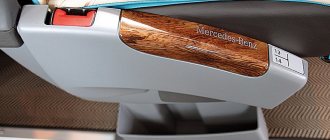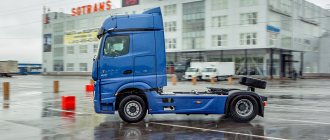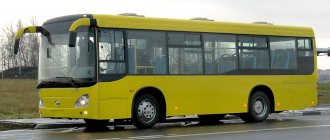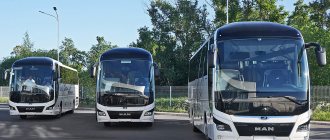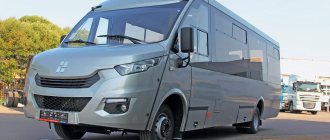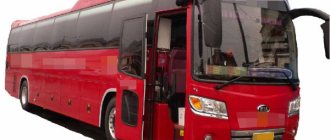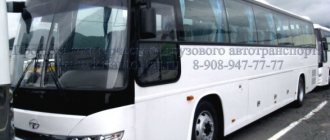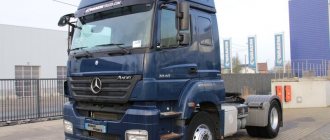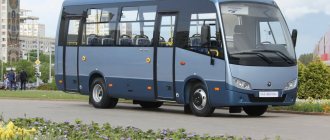Two years after the demonstration of the prototype of the city bus with extra large capacity Mercedes-Benz CapaCity in the fall of 2007 in Mannheim, it was approved in the model range of EvoBus GmbH. The uniqueness of this metric is that with an overall length of 19.54 m, the newborn does not fit into the current limit in Germany - 18.75 m. However, the German Ministry of Transport has given permission for the operation of this “boa constrictor” in German cities. Moreover, a similar concession is now expected for other European cities where CapaCity is expected to be used. Having carried out a blitz test of a newbie in Mannheim, I began to understand why it is so attractive for passenger transport.
Why with a trailer?
As soon as we left the EvoBus parking lot, I mentally began to search for an explanation for the German megalomania. Well, why was it necessary to build an almost 20-meter bus when the Mercedes-Benz production line already has an 18-meter Citaro G?! With three axles, it is available in three and four-door versions, with diesel and gas engines (Citaro G CNG), with a number of seats from 37 to 59 and a maximum capacity of 158 and 160 people. There is even a version with a combined drive Citaro G BlueTec Hybrid, designed to carry 140 passengers (37 sitting and 103 standing). Here is the answer to the first question: CapaCity’s capacity is no less than 193 passengers, i.e. more than any other modification.
The presence of a fourth axis is also justified. Actually, the fourth and last axle remained steerable, and the additional third was driven by an engine located in the rear overhang. This layout solution improved the weight distribution along the axes and contributed to better controllability of the vehicle. Suffice it to say that the turning circle of the CaraCity is the same as that of the Citaro G, although the difference in overall length is 1.6 m! Fears of mediocre maneuverability turned out to be exaggerated: the bus “drew” turns at road junctions and intersections, like an experienced designer of curves on his Whatman paper using a compass.
Family unification
By creating CapaCity, the Germans sought to unify their products and make them as cheap as possible. For this purpose, for example, the rear axle of the Integro M and Travego models (depending on the modification) was taken. The front suspension was made completely independent. The smoothness of the ride has increased, the level of noise and vibration has decreased. The German government uses tax incentives to encourage carriers who install wheelchair access ramps. Knowing this, transport operators order ramps, but not the latest models, but those that are simpler and cheaper.
The front part and the bellows are designed functionally and concisely: there is nothing superfluous here
The Mannheim plant offers customers a body and specifies the possible number of seats, but the upholstery material and colors are chosen by the client. Everyone knows that modern buses are becoming more expensive by about 5% per year. But given the rise in prices for metals, including aluminum, the rise in price is even greater. Add to this the rise in prices for energy resources and transportation, plus inflation, and you will understand that the rise in prices may exceed this level. However, EvoBus GmbH solved the problem of supplying steel from Poland, and for 15 years the price remained constant for them! In other words, not a single extra eurocent was taken from clients.
An undeniable advantage of the Citaro family is the use of identical panels at the front, and the CapaCity is no exception in this sense. Due to the low floor level and low roof, it was possible to save on total weight. In addition, this made it possible to heat it better in cold weather (and not only in winter), as well as to cool it more efficiently and with less energy consumption in spring and summer. The fact that the family is full of interchangeable parts is also to the benefit of carriers: when using buses of different models, the loss of time to eliminate any breakdowns is insignificant.
The front part of the cabin has a large storage area. Length markings are visible on the floor in 25 cm increments.
Even if you were Sherlock Holmes himself, even in the middle of the day you wouldn’t find a spare tire in the depths of CapaCity, because... it’s not there! The creators of the bus reasoned like this: why constantly carry an extra 100 kg with you, because this is, in fact, the weight of two passengers. Practice shows that the driver is not always able to cope with replacing a broken tire: either his back hurts, or he lacks strength, or there is bad weather outside. After all, the bus is not on a country road, but within a populated area. And as a result, the departure of the technical team to the place of the forced stop was considered more effective.
By the way, about stops: the height of the bus floor above the road level in the front door is 320 mm (in all others - 340 mm). The lower step in the rear overhang is located at the same level. This is due to the fact that the height of the passenger platform in Europe is determined the same everywhere. That is why in Germany, and in France, and in other countries, a passenger airliner can drive up level with the platform. I made a couple of test stops at uninhabited points and was pleased with the result: excellent visibility, light steering and excellent handling allowed me to make a real “millimetre”. I’m not sure that driving an Ikarus or a domestic “articulated” car I would have managed to do this on the first try.
The test version of the bus has additional measuring equipment installed. Monitors allow you to track critical operating parameters in real time
The unification of CapaCity with other models of the family is clearly visible in the interior design. And the point is not only in the use of identical materials, but also in layout solutions. As on other large city airliners, the seat posts are retracted under the seats, allowing bags and packages to be placed downwards. All protrusions and edges of rigid structures are rounded, and this is the standard for passive safety: you won’t get hurt at such corners. Despite the rigidity of the plastic chairs, sitting on them is quite comfortable - the surface of the back and cushion is covered with soft material. The grab handles are mounted at a comfortable height and the bright yellow paint makes them very visible throughout the cabin.
To optimize the list of options and factory-fitted options, EvoBus GmbH specialists took “washers” from customers and studied traffic patterns on certain routes using data from the on-board recorders. This information was analyzed with information on the number of passengers, road profile, etc. As a result, carriers were given recommendations on the optimal configuration of buses. Now the plant’s computer database contains data on dozens of regular customers, which allows it to offer customers new machines adapted for a specific type of transportation.
The double axle on the trailer is a feature that distinguishes the almost 20-meter CapaCity from the 18-meter Citaro G
Let's fire on the accordion!
The driving position is so comfortable that it seems as if your measurements were taken. I wish I could find these “cutters” and shake their hands like a man as a sign of gratitude. All controls are at hand, everything is in sight. In general, there is nothing to complain about. The start of an empty car (a few passengers don't count) is very energetic. This is thanks to the 354-horsepower turbodiesel, the most powerful in the entire line of Mercedes accordions. For comparison: the 18-meter Citaro G uses a motor with an output of 299 hp. and even on the Citaro G CNG gas model, the engine power is only 326 horsepower.
CapaCity picks up speed easily, but the main thing is not to get carried away. Firstly, cities are full of restrictions. Secondly, do not forget that there are two passenger compartments at the rear, with a “tail” wagging in turns. You get used to the long length quite quickly, but you cannot relax. Drivers of oncoming buses warmly raise their hands and look at the newcomer with interest: whatever you say, he hasn’t managed to become familiar even in Mannheim.
Before getting behind the wheel, I took a ride as a passenger in different seats of the bus. The most interesting thing “in Kamchatka” is in the stern of the trailer. From there, the entire passenger space, including the front cabin, is at a glance. And if there are no people standing in the aisle, the road is clearly visible. There is only one drawback to the landing: the engine compartment is located nearby, and the noise of the running engine prevents you from fully enjoying the trip. There is also no saving backrest for the chair in front, so you have to hold on to the handrail. Whatever you say, no one is safe from sudden braking. In Germany, although they drive more carefully than in Russia, things can happen there too...
In the middle part of the cabin, there is only one pleasure from movement - the landscape outside the window. But if the bus is driving along a narrow one-way street, you are sitting backwards or standing in the articulation bellows, and the speed is close to maximum, then the picture will be blurry. The front part of the cabin with seats facing the direction of the bus is a different matter. Here the noise level is lower and the visibility is better. As for the entrance, there is no need to worry about it in advance, as in two-door manholes: wide openings are located nearby.
Technical characteristics of Mercedes-Benz CapaCity
| Engine | |
| Model | OM 457 hLA (Euro 4), I-6 turbodiesel, 24 v |
| Type and working volume, cm3 | 11 967 |
| Power max, hp | 354 |
| Torque max, Nm | 1600 at 1100 min-1 |
| Transmission | |
| Transmission | ZF 6 HP 592, hydromechanical |
| Retarder | Voith DIWA 864.3 |
| Steering and axles | |
| Steering | ZF with servo drive |
| Front suspension | Independent ZF RL 75 EC |
| Middle Bridge | Portal, ZF RL 75 A |
| Rear drive axle | Portal, AV 132/87° |
| Refueling volumes | |
| Lubrication system, including filter, l, min/max | 27/ 32 |
| Cooling system, l | 22 |
| Fuel tank, l | 400 |
| AdBlue container, l | 45 |
| Windshield washer, l | 22 |
| Other options | |
| Dry/total weight, kg | 18 545/ 32 000 |
| Turning diameter, mm | 22 850 |
| Passenger capacity, persons | 193 |
| Number of seats | 37 |
| Tire size | 275/70 R22.5 |
| Air pressure in tires: front/rear, bar | 8,5/ 6,5 |
...Twilight is coming, and you have to add headlights to the side lights that are on. At the border of day and night they are almost useless, but after a few minutes a spot of light appears right in front of the bus. The optics cope well with the functions assigned to them, and the high beam is generally a delight: not only the roadway is illuminated, but also the side of the road. The dashboard lighting is smooth, calm, without distracting bright areas. Usually bus drivers know all the buttons and keys by heart and can use them with their eyes closed. But even if a novice is driving, he will quickly get used to it and get used to his command console.
You really appreciate the benefits of civilization in the dark. Thanks to the automatic transmission, driving a long bus is easy - your hands are only occupied with the steering wheel. Only when changing lanes do you have to use the steering column switch for direction indicators and the wiper flag during precipitation. Yes, you also need to open and close doors at stops. Otherwise, no distractions. In a word, the “automatic” is “one hundred percent” justified here.
To be honest, I expected that on narrow, poorly lit or not lit sections of the road, the nervous tension would be caused by passing oncoming trucks and parked cars. But I didn’t experience any discomfort. The power of the headlight and the sense of width allow you to drive almost flush to the right side of the road. This leaves plenty of space on the left for safe passage with oncoming traffic. And parked cars are clearly visible in the dark thanks to the signal lights on the sides. Anyone can experience jitters from driving through CapaCity - the owner of a small car standing at a traffic light, sitting in the cab of an overtaken van, or waiting for the green light for a pedestrian on the sidewalk, but not the driver of an almost 20-meter long city car. The designers did everything in their power to ensure that this bus brought joy to passengers and profit to carriers. The rest is not in their competence.
